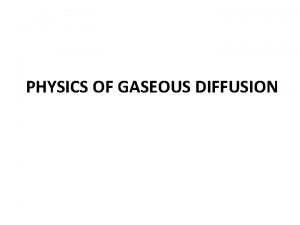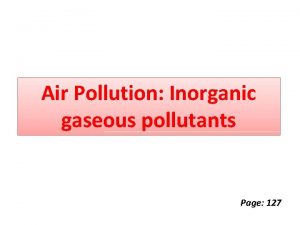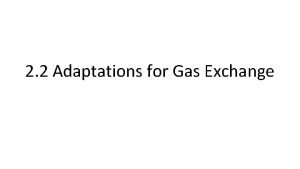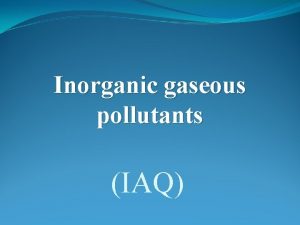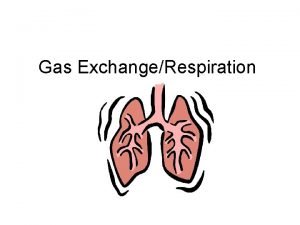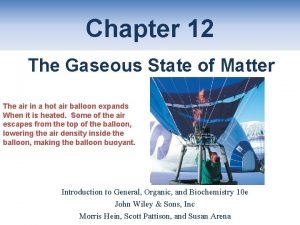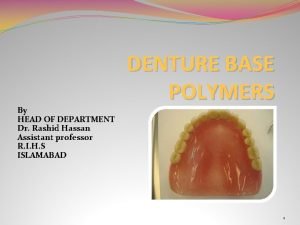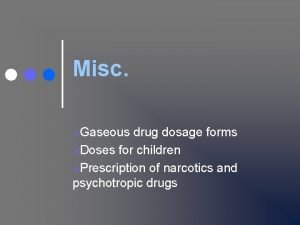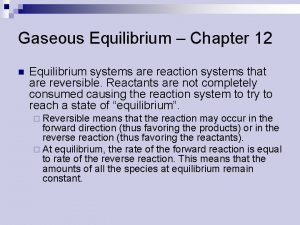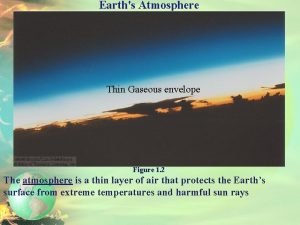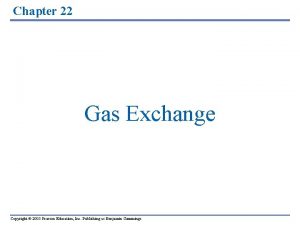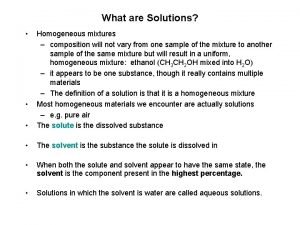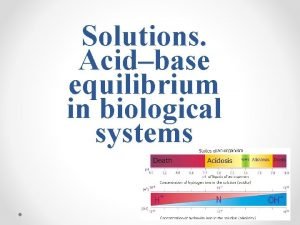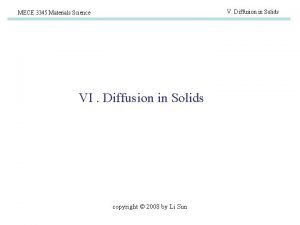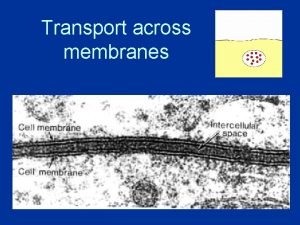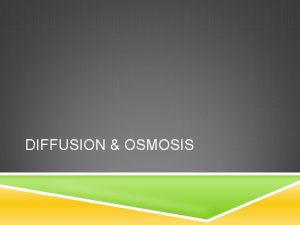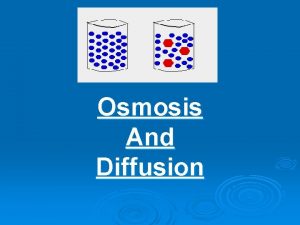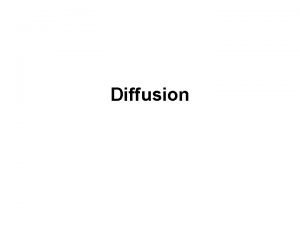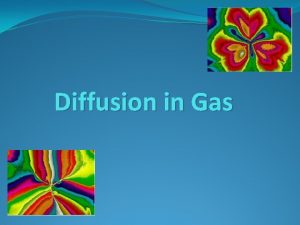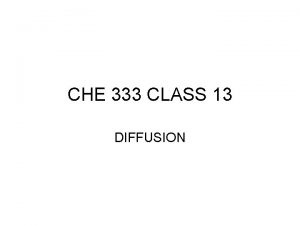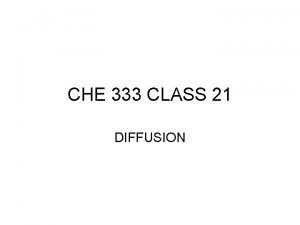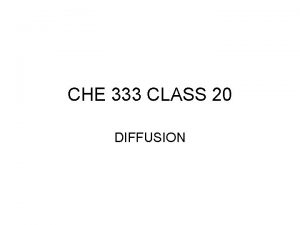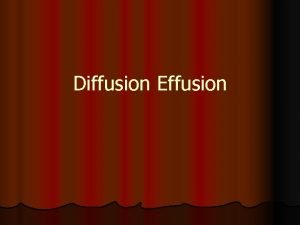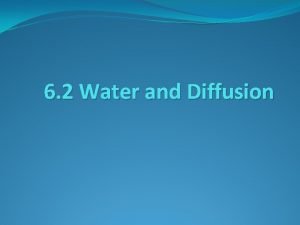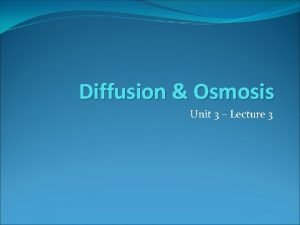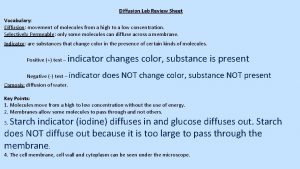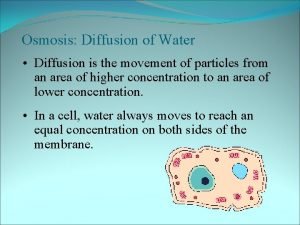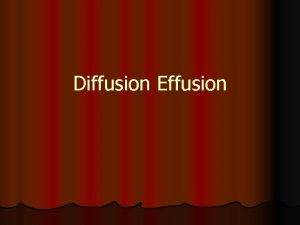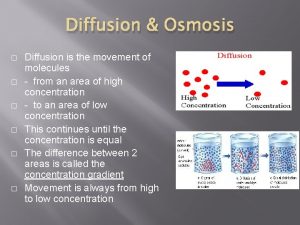PHYSICS OF GASEOUS DIFFUSION GASEOUS MOVEMENT IN RESPIRATORY

































- Slides: 33

PHYSICS OF GASEOUS DIFFUSION

GASEOUS MOVEMENT IN RESPIRATORY SYSTEM • After the alveoli are ventilated with fresh air, the next step in the respiratory process is DIFFUSION of various gases.

DIFFUSION OF GASES • The process of diffusion is simply random molecular motion of molecules in both ways through the respiratory membrane.

RATE OF DIFFUSION • The rate of diffusion of gas is directly proportional to the partial pressure of that gas.



TOTAL PRESSURE OF A GAS • The pressure of a specific gas acting on the surfaces of the respiratory passages and alveoli is proportional to the summated force of impact of all of its molecules. • This means total pressure of a gas is directly proportional to the concentration of the gas molecules.

PRESSURE OF GASES IN WATER & TISSUES • Gases dissolved in water or in the body tissues exert pressure. • The pressure of a dissolved gas in a fluid is determined by the concentration and solubility coefficient. • Pressure= concentration of gas/solubility coefficient of that gas

VAPOUR PRESSURE • The pressure that the water molecules exert to escape through the surface is called VAPOUR PRESSURE of the water. • It is 46 mm Hg at normal body temperature of 37 degree F. • The vapour pressure depends on the trmperature of water.

PRESSURE DIFFERENCE FOR DIFFUSION • The NET DIFFUSION of gas from the area of high pressure to the area of low pressure is equal to the number of molecules bouncing in this direction minus the number bouncing in the opposite direction & this in turn is proportional to the gas pressure difference between the two areas called PRESSURE DIFFERENCE FOR DIFFUSION.

Net rate of diffusion of fluids depends upon: • • • 1. 2. 3. 4. 5. 6. Pressure difference. Solubility of gas. Diffusion through which gas must diffuse. Cross-sectional area of the fluid. Molecular weight of the gas. Temperature of the fluid.

DIFFERENCE BETWEEN ALVEOLAR AIR & ATMOSPHERIC AIR • 1. Alveolar air is only partially replaced by atmospheric air with each breath. • 2. Oxygen is constantly being absorbed from the alveolar air. • 3. Carbondioxide is constantly diffusing from the pulmonary blood into the alveoli.

RATE AT WHICH ALVEOLAR AIR IS RENEWED BY ATMOSPHERIC AIR • At normal alveolar ventilation approx. half the gas is removed in 17 seconds.

IMPORTANCE OF SLOW REPLACEMENT • This slow replacement is of importance in preventig sudden changes in gaseous concentration of blood.

OXYGEN CONCENTRATION & ITS PARTIAL PRESSURE IN ALVEOLI • 1. The more rapidly oxygen is absorbed by blood, the lower becomes its concentration in the alveoli. • 2. The oxygen concentration in the alveoli is 10 mm Hg & is controlled by---Rate of its absorption into blood AND Rate of entry of new oxygen into lungs. • 3. Marked increase in alveolar ventilation can never increase the alveolar PO 2 above 149 mm Hg as long as person is breathing in normal atmospheric air.

CO 2 CONC. & ITS PARTIAL PRESSURE IN ALVEOLI • 1. Normal rate of alveolar ventilation for CO 2 is 4. 2 liters/min. CO 2 pressure in alveli is 40 mm Hg. • 2. The alveolar PCO 2 increases directly in proportion to the rate of CO 2 excretion. • 3. Alveolar partial pressure of CO 2 decreases in inverse priportion to alveolar ventilation.

DIFFUSION OF GASES THROUGH RESPIRATORY MEMBRANE

THE RESPIRATORY UNIT • • 1. 2. 3. 4. • It is composed of: Respiratory bronchiole Alveolar ducts Atria Alveoli

RESPIRATORY MEMBRANE • The gaseous exchange between the ALVEOLAR AIR & the PULMONARY BLOOD occurs through membranes of all the termina; portions of lungs. These membranes are known as RESPIRATORY MEMBRANE.

LAYERS OF RESPIRATORY MEMBRANE 1. Fluid layer lining alveoli. 2. The alveolar epithelium. 3. An epithelial basement membrane. 4. A very thin interstitial space between alveolar epithelium & capillary membrane. • 5. A capillary basement membrane. • 6. The capillary endothelial membrane. • •

FACTORS AFFECTING DIFFUSION THROUGH THE RESPIRATORY MEMBRANE • The factors that determine how rapidly a gas will pass through the membrane are: • • 1. Thickness of respiratory membrane. 2. Surface area of respiratory membrane. 3. Diffusion coefficient of the gas. 4. Pressure difference across respiratory membrane.

DIFFUSING CAPACITY OF RESPIRATORY MEMBRANE • It is defined as the volume of a gas that diffuses through the membrane each minute for a pressure difference of 1 m Hg.

MEASUREMENT OF DIFFUSING CAPACITY • The oxygen diffusing capacity can be calculated from measurement of: • 1. Alveolar PO 2. • 2. PO 2 in pulmonary capillary blood. • 3. Rate of oxygen uptake by blood.

VENTILATION PERFUSION RATIO • It is DEFINED as the ratio of alveolar ventilation to blood flow. • FORMULA: • VPR=VA/Q

WHEN VPR IS ZERO • It MEANS VPR is without any alveolar ventilation because the air in the alveolus has come to equilibrium along with the blood oxygen & carbondioxide gas.

WHEN VPR EQUALS INFINITY • It means that there is no capillary blood flow to carry oxygen away or to bring carbondioxide to alveoli. So, the air that is inspired loses no oxygen to blood & it gains no CO 2.

WHEN VPR IS NORMAL • This means there is optimal alveolar capillary blood flow & exchange of oxygen and CO 2 THROUGH RESPIRATORY MEMBRANE.

PHYSIOLOGICAL SHUNT • When some part of venous blood passing through the pulmonary capillaries does not become OXYGENATED, this is known as SHUNTED BLOOD. • The total amount of shunted blood per minute is known as PHYSIOLOGICAL SHUNT.

How to measure physiological shunt? • It is measured by analysing the concentration of oxygen in both mixed venous blood & arterial blood along with simultaneous measurement of cardiac output.


PHYSIOLOGICAL DEAD SPACE

WASTED VENTILATION • When ventilation of some of the alveoli is great BUT alveolar blood flow is low, there is then far more available oxygen in the alveoli than can be transported away by blood. This extra ventilation of alveoli is termed as WASTED VENTILATION.

PHYSIOLOGICAL DEAD SPACE • The sum of alveolar wasted ventilation and ventilation of anatomical dead space areas is termed as PHYSIOLOGICAL DEAD SPACE.
 Diffusion vs facilitated diffusion
Diffusion vs facilitated diffusion What is expansion diffusion
What is expansion diffusion Diffusion of gases across respiratory membranes:
Diffusion of gases across respiratory membranes: Conducting zone and respiratory zone
Conducting zone and respiratory zone My very excited mother planets
My very excited mother planets Inorganic gaseous pollutants of air
Inorganic gaseous pollutants of air Xeromorphic plants
Xeromorphic plants Inorganic gaseous pollutants of air
Inorganic gaseous pollutants of air Grasshopper respiratory system
Grasshopper respiratory system Gaseous state chapter
Gaseous state chapter Contraction porosity denture
Contraction porosity denture Gaseous exchange in animals
Gaseous exchange in animals Gaseous dosage form
Gaseous dosage form Gaseous equilibrium
Gaseous equilibrium Gaseous envelope of the sun
Gaseous envelope of the sun Gaseous exchange grade 11 practical
Gaseous exchange grade 11 practical The earthworm
The earthworm Are solutions homogeneous
Are solutions homogeneous Phosphate buffer system equation
Phosphate buffer system equation Dosage form of drug
Dosage form of drug At 500 k one mole of gaseous oncl
At 500 k one mole of gaseous oncl Movement area
Movement area Example of axial movements
Example of axial movements Physics movement and position
Physics movement and position Forces and motion igcse
Forces and motion igcse Modern physics vs classical physics
Modern physics vs classical physics University physics with modern physics fifteenth edition
University physics with modern physics fifteenth edition Ib physics ia sample
Ib physics ia sample Diffusion mechanism
Diffusion mechanism Diffused junction
Diffused junction Active or passive transport
Active or passive transport Facilitated diffusion high to low
Facilitated diffusion high to low La loi de diffusion
La loi de diffusion Identity diffusion
Identity diffusion


